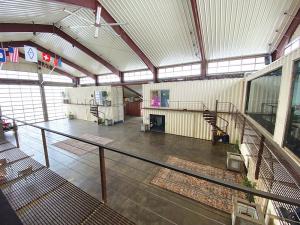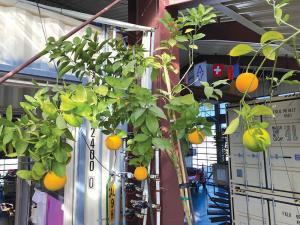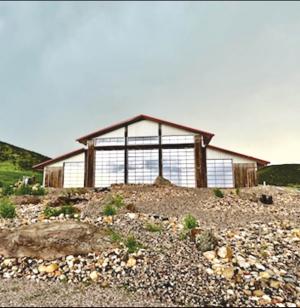Food Producing Barn Built From 14 Shipping Containers
Nico March says he became interested in shipping containers more than 25 years ago in San Diego when he observed the many ways the military was configuring them into movable command centers, bathrooms, kitchens, and more. The idea of creative uses for shipping containers kept rattling around in March’s head, and today, he oversees the operation of “The Bark,” an ultra-efficient, sustainable structure that incorporates 14 shipping containers 8 ft wide by 40 ft. long and an assortment of repurposed and recycled materials.
“It’s too big to call a barn and too small for an ark, so we call it ‘The Bark,’” March says. The 13,000-sq. ft. structure in southeastern Wyoming is used to grow an array of fruits, vegetables, mushrooms, and fish on three levels. It also includes two separate basements that were dynamited out of solid granite. The Bark is focused on energy efficiency, with features such as solar panels, geothermal heating, cross ventilation, automatic windows, and heat-stack effects for cooling. These features reduce the building’s reliance on non-renewable energy while also promoting a comfortable and healthy indoor environment.
Each container has its own function. The greenhouse produces fruit and vegetables and helps regulate humidity. A recirculating aquaponics system produces fish, while freshwater prawns provide algae control in fish tanks. Mushrooms are grown for food and carbon dioxide production, which helps other plants grow.
Recycled and repurposed materials are used throughout The Bark. Picture windows are made of 3/4-in. thick hockey arena glass panels, spiral staircases are made from catwalks, and wood from Wyoming snow fences cover interior and exterior walls. Aquaculture tanks and grow beds use IBC totes. Rock quarry conveyor belts are used for anti-slip flooring in the tack and feed areas.
Many of the building materials were acquired from Repurposed Materials, Inc. of Brighton, Colo., which has warehouses in five U.S. locations. “You’ll find all kinds of crazy, offbeat industrial castoffs at our five warehouse locations,” says Damon Carson, company founder.
March says The Bark project’s goal was to build a self-sustaining building that could maintain itself with food and electricity and provide a place to live, work, and play.
Plants and vegetables grown in the Bark include numerous fruit trees (peaches, pears, navel and blood oranges, mangos), and produce (wasabi, heirloom tomatoes, basil, watermelons). Nutrient-rich water from the fish tanks is recycled to irrigate the plants and trees.
The Bark has a mudroom entrance, a gallery, a commercial kitchen, and a pantry. Its root cellar is kept at 55 degrees. A workshop and metal shop have a welding table, plasma cutter, and ample storage. There’s an office and conference room and, for personal comfort, a swim spa and workout area. One container is a garage for RV storage, and another is the control room for water and power with both electricity and water emergency backup.
Contact: FARM SHOW Followup, Nico March, The Bark Container Home, Wyoming; Damon Carson (ph 877-282-8733; damon@repurposedmaterialsinc.com; www.repurposedmaterialsinc.com).

Click here to download page story appeared in.
Click here to read entire issue
Food Producing Barn Built From 14 Shipping Containers FARM HOME Food Nico March says he became interested in shipping containers more than 25 years ago in San Diego when he observed the many ways the military was configuring them into movable command centers bathrooms kitchens and more The idea of creative uses for shipping containers kept rattling around in March’s head and today he oversees the operation of “The Bark ” an ultra-efficient sustainable structure that incorporates 14 shipping containers 8 ft wide by 40 ft long and an assortment of repurposed and recycled materials “It’s too big to call a barn and too small for an ark so we call it ‘The Bark ’” March says The 13 000-sq ft structure in southeastern Wyoming is used to grow an array of fruits vegetables mushrooms and fish on three levels It also includes two separate basements that were dynamited out of solid granite The Bark is focused on energy efficiency with features such as solar panels geothermal heating cross ventilation automatic windows and heat-stack effects for cooling These features reduce the building’s reliance on non-renewable energy while also promoting a comfortable and healthy indoor environment Each container has its own function The greenhouse produces fruit and vegetables and helps regulate humidity A recirculating aquaponics system produces fish while freshwater prawns provide algae control in fish tanks Mushrooms are grown for food and carbon dioxide production which helps other plants grow Recycled and repurposed materials are used throughout The Bark Picture windows are made of 3/4-in thick hockey arena glass panels spiral staircases are made from catwalks and wood from Wyoming snow fences cover interior and exterior walls Aquaculture tanks and grow beds use IBC totes Rock quarry conveyor belts are used for anti-slip flooring in the tack and feed areas Many of the building materials were acquired from Repurposed Materials Inc of Brighton Colo which has warehouses in five U S locations “You’ll find all kinds of crazy offbeat industrial castoffs at our five warehouse locations ” says Damon Carson company founder March says The Bark project’s goal was to build a self-sustaining building that could maintain itself with food and electricity and provide a place to live work and play Plants and vegetables grown in the Bark include numerous fruit trees peaches pears navel and blood oranges mangos and produce wasabi heirloom tomatoes basil watermelons Nutrient-rich water from the fish tanks is recycled to irrigate the plants and trees The Bark has a mudroom entrance a gallery a commercial kitchen and a pantry Its root cellar is kept at 55 degrees A workshop and metal shop have a welding table plasma cutter and ample storage There’s an office and conference room and for personal comfort a swim spa and workout area One container is a garage for RV storage and another is the control room for water and power with both electricity and water emergency backup Contact: FARM SHOW Followup Nico March The Bark Container Home Wyoming; Damon Carson ph 877-282-8733; damon@repurposedmaterialsinc com; www repurposedmaterialsinc com
To read the rest of this story, download this issue below or click
here to register with your account number.









